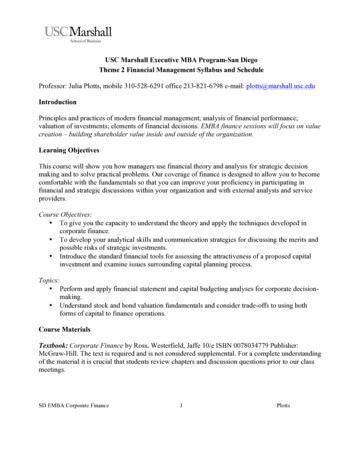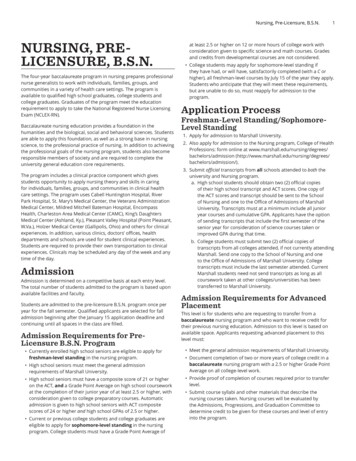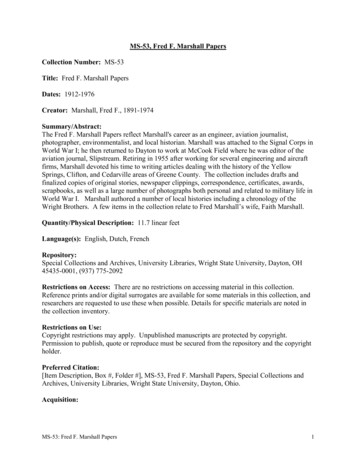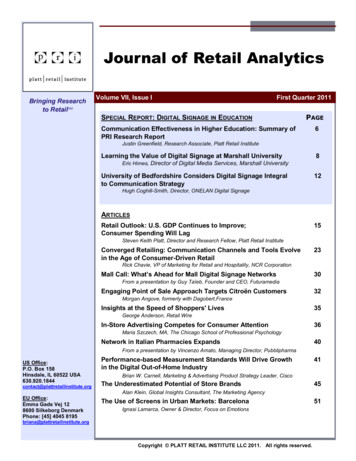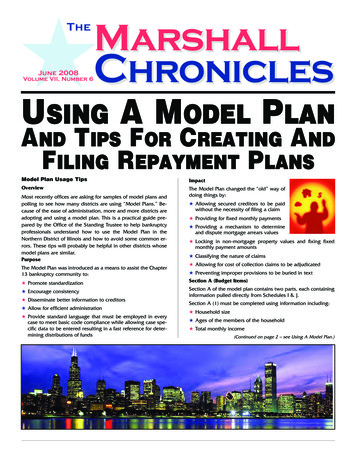
Transcription
#TheMarshallChroniclesUSING A MODEL PLANJune 2008Volume VII, Number 6AND TIPS FOR CREATING ANDFILING REPAYMENT PLANSModel Plan Usage TipsOverviewMost recently offices are asking for samples of model plans andpolling to see how many districts are using “Model Plans.” Because of the ease of administration, more and more districts areadopting and using a model plan. This is a practical guide prepared by the Office of the Standing Trustee to help bankruptcyprofessionals understand how to use the Model Plan in theNorthern District of Illinois and how to avoid some common errors. These tips will probably be helpful in other districts whosemodel plans are similar.PurposeThe Model Plan was introduced as a means to assist the Chapter13 bankruptcy community to:# Promote standardization# Encourage consistency# Disseminate better information to creditors# Allow for efficient administration# Provide standard language that must be employed in everycase to meet basic code compliance while allowing case specific data to be entered resulting in a fast reference for determining distributions of fundsImpactThe Model Plan changed the “old” way ofdoing things by:# Allowing secured creditors to be paidwithout the necessity of filing a claim# Providing for fixed monthly payments# Providing a mechanism to determineand dispute mortgage arrears values# Locking in non-mortgage property values and fixing fixedmonthly payment amounts# Classifying the nature of claims# Allowing for cost of collection claims to be adjudicated# Preventing improper provisions to be buried in textSection A (Budget Items)Section A of the model plan contains two parts, each containinginformation pulled directly from Schedules I & J.Section A (1) must be completed using information including:# Household size# Ages of the members of the household# Total monthly income(Continued on page 2 – see Using A Model Plan.)
June 2008Volume VII, Number 6Using A Model PlanHelpful Tip: This section contains an “or” and one of the optional choices must be completed. Payments that are to be made directly to the creditor should also appear on Schedule J. Paymentsbeing made via the trustee or surrendered property thus shouldnot appear on Schedule J.(Continued from page 1.)# Total monthly expenses# Total dollars available for plan paymentsSection D (Payment by debtor to the trustee; plan term andcompletion)Section A (2) must be completed using information including:# Amount of charitable contributionsgiven each monthSection D sets forth the monthly terms of the proposed plan andthe number of months that the plan will last. There is also a “totalpayments” line that should equal months times monthly payment amount.# Number of months those contributions have been givenSection B (General Provisions)Helpful Tip: The monthly plan payments can vary from month tomonth and these variations should be spelled out in this section.The “total payments” line should always total more than all thedebts to be paid through the plan.Section B of the model plan contains four parts, each containingstandard provisions that are applicable to all cases in this district.For all cases, this section:# Provides for mortgage arrears claim treatment, including provisions that once the arrears claim is paid the mortgage isdeemed “reinstated”Section E (Disbursements by the trustee)Section E sets out the claims that are to be paid by the trusteein the plan from the debtor’s plan payments. As in any plan,trustee fees are paid first as required by the bankruptcy code.Secondly, there is a section to list current mortgage paymentsthat are to be maintained by the trustee. The third part to SectionE outlines the secured creditors (non-mortgage) that will be paidby the trustee. The creditor name must be listed, as well as thesecured portion of the claim and an interest rate if applicable. Themodel plan was designed so that upon confirmation, the valueof the secured collateral listed here will be adjudicated and determined with some finality. There is also a space to provide forfixed monthly payments and those payments must always beprovided.# Provides for costs of collections# Lien release languageSection C (Direct payment of claims by debtor)Section C of the model plan provides both check boxes and fillin lines so that the plan can provide for the payments that arebeing made directly by the debtor, indicate which creditor is tobe paid and how much is due to be paid to that creditor eachmonth.TheMarshall ChroniclesHelpful Tips:The Editorial Staff: Cheryl Jones, HVB and Dave Latz.# The monthly amount to be paid to maintain current mortgagepayments can be altered by the creditor sending a letter to thetrustee and the debtor and the debtor attorney without theneed to modify the plan through judicial process each time.Contents and Contributors:Using A Model Plan And Tips For Creating And Filing RepaymentPlans, pg. 1 .O. Anthony OlivadotiTrustee Matters, pg. 3 .Marilyn O. MarshallJuly Events, pg. 5 .Dave LatzDeficiency Claims For Mortgage Debts, pg. 5.Rosalind LanierAdequate Protection Payments, pg. 6 .Rita M. SaundersIS News – Attorney Fees, pg. 6 .Cliff TarranceThose Wonderful Pets, pg. 7 .Chapter 13 Staff MembersTopic: New Arrivals, pg. 7 .Sulethé MasonWalk & Roll Wrap Up, pg. 7 .Rita M. SaundersTrivia Quiz: Just Some Fun Trivia, pg. 8.Staff SubmissionDid You Know? Horseradish, pg. 8.Staff Submission# Fixed monthly payments are typically determined by takingthe total secured claim to be paid and dividing that number bythe number of months in the plan.# Secured claimants must be provided for in this section. Secured claimants that are not listed here will not be paid correctly.# Fixed payments have to be scheduled. Paying a 1,000 claimat 0.00 per month not only makes no sense, it cannot be administered.Newsletter Information:If you would like to contact us or submit ideas or articles for the newsletter, you can doso by: e-mailing us at newsletter@chi13.com, dropping your submission or idea in the anonymous newsletter folder located in the mail room, or leaving them with Dave Latz.Please remember when making a submission to the newsletter, it must be: type-written and submitted by the third Wednesday of the month via e-mail, a Word document or an ASCII file.We also ask that anyone who attends a seminar please be prepared to furnishthe committee with a detailed article on its subject.You may also view this edition of The Marshall Chronicles, as well as all thepreviously published issues, on the Chapter 13 Trustee website at http://www.chicago13.com/.Section F (Priority)Section F lays out the priority and sequence for claims to be paidby the trustee. Money typically flows from top to bottom in thedistribution order. Claims are paid:1. Trustee’s authorized fee2. Current mortgage payments3. Secured claims listed in E (3)4. Debtor attorney’s fees5. Mortgage arrears6. Priority claims(Continued on page 4.)2
June 2008Volume VII, Number 6Trustee MattersWillie Banks, Jr., Will Not Receive Discharge As MentorOn August 27, 2001, I visited the Office of the Chapter 13 Trustee, WillieBanks, Jr., as part of my training to become a Chapter 13 Trustee. From thatday forward, Willie Banks, Jr. became my mentor. When, my UST Coordinator, Howard “Chip” Wilkes informed me that Mr. Banks office would be oneof the three offices where I would train, I was elated. You see, I was born inAlexandria, Louisiana; so imagine how I felt having landed the job of mydreams in Chicago and also being sent to train in my hometown, Alexandria.It just couldn’t get any better for a “lil ol’ country girl” from Alexandria.My “thank you” card along with Glenn Stearns, Janna Countryman, Tim Ivy,Krispen Carroll, James Henley, and other Chapter 13 Trustees, who were alsoChapter 13 Trustees: Sylvia Brown, James Henley, Willie Banks, Jr.,sent to Alexandria, are neatly placed on a bulletin board in his office for allto see. He never misses an opportunity to say how proud he is of all of us. Tammy Terry, Marilyn O. Marshall and David Peake.At the Mid-Year meeting in New Orleans, Willie Banks, Jr., announced that after 10 years of service to the job he loved, he had decided topursue another goal. Willie Banks, Jr., resigned his position as Chapter 13 Trustee and will announce his candidacy for Congressman forLouisiana’s fourth Congressional District on July 4th. Robin Weiner, the President of the NACTT, yielded her platform to Willie to make thisannouncement and it was handled in the manner that Willie Banks, Jr., handles everything. He was classy, gracious, detailed, witty, humble, and he spoke in such a mild manner. I wasn’t surprised that he received a standing ovation from the audience.“Mentors are advisors, people with career experience willing to share their knowledge.” Willie has been more than just a mentor. As withany task he undertakes, he has gone beyond the call of duty to advise me, support me, offer emotional and moral encouragement, and togive me specific feedback on my performance. And, he has also freely given the same toothers.When I received the invitation to attend his Discharge Party, I smiled and was very impressed, because I could see Willie Banks, Jr., written all over the planning by his staff, eventhough the party was a surprise to him. I knew that he had molded and set the same example for his staff that he set for me.I know I am not losing a mentor but will be gaining the benefit of the experience in his newendeavors. Willie Banks, Jr., is a winner and is loved dearly by the Bankruptcy Community.Marilyn O. Marshall, Chapter 13 Trustee3
June 2008Volume VII, Number 6Using A Model Plantion payments will be made by the trustee in the fixed payment amount or as indicated in paragraph G if it differs. If nopayment is indicated, the trustee will not pay it and thecreditor will most likely (they should) object to confirmationof the plan. Pro rata distribution is no longer available for E3creditors.(Continued from page 2.)7. Specially classified non-priority unsecured claims8. General unsecured claims4. Filing plans last minute. No matter how efficient the modelplan may be, no one can review the plan for modificationswithout adequate time. Filing plans on the morning of or theday before hearings not only impinges on the due processrights of the trustee and the creditors, but also raises questions of good faith. Just don’t do it.Helpful Tip: Note that the lower the fixedpayment provided for E3 creditors, thefaster the debtor attorney will get theirfees paid. This trustee pays all 100% creditors in full before fundstrickle down to the remaining classes of creditors.Section G (Special Terms)5. Numbers just don’t add up. Each fill-in section is pulled fromthe schedules. There should be consistency among the numbers used. For instance, if the number of persons in the household is three on Schedule I, it should be the same on themodel plan as well as the B22C form. Check for consistencyand accuracy before filing the plan.Section G allows the standard plan to be modified to fit the particular need in each case. Most contingencies and computationshave been provided for in the base model plan, but on occasionsome individual case tweaking may be necessary. This sectioncannot be used to re-write the model plan altogether. This section is probably the most often misused and abused section inthe model plan.Avoid Mistakes When Confirming Or Rejecting PlansHelpful Tip: If at all possible, don’t use this section. A good andproper manner to use this section would be to list creditorswhere the collateral is being surrendered. The trustee will belooking to see if all secured creditors are addressed in the plan.Other additions to this section typically cause confusion as theycontradict other sections of the plan.How to get a Plan confirmed# Make sure all prior bankruptcy cases are listed.# Make sure the debtor received Pre-bankruptcy Credit Briefing180 days prior to filing and that the debtor received and readthe Notice required pursuant to §342(b).# Make sure the debtor has made their first payment 30 daysafter the petition is filed and that the debtor is current on payments at the time of confirmation.Section H (Summary of payments to and from the trustee)Section H is exactly what it is titled, a fast and quick summary ofthe plan. This section is a compilation of all the previously filledin spaces in the model plan and in some versions calculates automatically. The summary section should contain no negativenumbers and should balance in the end. If the payments to bemade from the plan total more than the payments going into theplan, there is an obvious feasibility problem and this summarywill exhibit that discrepancy.# Make sure the payment is sent to the correct trustee address(lockbox) in order to avoid delay. If the debtor elects payrollcontrol, send the Payroll Order to Judge’s Chambers so thatdeductions can start promptly.# Make sure that all the schedules and other documents are accurate and complete. The debtor will be asked what specifically did he/she do in “good faith” to meet the requirements.Section I (Payroll Control)# Review the Model Plan and the Secured Property-Schedule D.Are adequate protection payments required to be made bythe trustee?The last Section I was added to assist the debtors in getting theirpayroll started as early as possible. Many debtors choose to havetheir plan deductions taken and sent to the trustee directly fromtheir employer. This section alerts the trustee of the debtors’ intentions and serves as the debtors’ authorization to enter a Payroll Order.# Review Schedule E to determine if the debtor owes a Domestic Support Obligation. Also, review Schedules I and J.# Make sure that Official Form B22C is correct and accurate, andthat the boxes at the top of the form are checked. The monthly net income must be itemized to show how it was calculated. Double check your CMI calculation and recheck the MeansTest calculation if applicable.Helpful Tip: In joint cases there must be some specificity indicated here as to whose employer will be making the deductions.Common ErrorsListed are some common errors found in filling out and filingmodel plans.# Make sure that the debtor has filed a federal tax return andhas provided it to the trustee, and that the tax returns filed forthe last four years with the Internal Revenue Service, State ofIllinois and local taxing authorities are provided to the trustee.1. Not checking “OR” boxes. Anywhere in the schedules or theplan where there is an “OR,” an option must be chosen.2. Using an incorrect version of the model plan. Keep up onthe changes and just don’t do it. The model plan goes throughoccasional revisions to keep up with changes in the law andthe most current version should always be used.# Make sure information on the debtor’s residence is listed sothat exemptions can be determined.# Make sure the debtor has met the requirements of the Liquidation Analysis.3. Failing to provide fixed payments or for adequate protection to secured creditors. Pre-confirmation adequate protec-(Continued on page 5.)4
June 2008Volume VII, Number 6Using A Model PlanCase AdministrationDeficiency ClaimsFor Mortgage Debts(Continued from page 4.)# If all of the above is satisfied and caseis confirmed, the trustee will disburseevery third Friday of the month afterpost confirmation review is completed. Post confirmation review is anaudit process to make sure trustee hascomplied with Plan.As we know, the foreclosure rate is at anational high due to the economy andseveral other factors such as unemployment, escalating interestrates and taxes. In the good times there were all kinds of creativeways that allowed individuals to obtain a mortgage who probablydid not qualify under more conservative conditions. Some peoplewere encouraged to get adjustable mortgages, so they could afforda pricier house and initially have a lower payment. Banks also offered individuals other options like principal and interest-only payments, or you could purchase a house and write part of the firstmortgage balance into a second mortgage, so new homebuyerscame out of the closing with a first and a second mortgage payment.Other Confirmation Considerations# §1325(a)(3): Good faith test still applies regardless of incomelevel.# §1322(a)(4): A debtor may provide for less than full paymenton a claim for support that has been assigned to or is owed toa governmental unit if the debtor’s plan is a sixty-month plan.The mortgage deficiency balance is created when the property issold for less than the original mortgage amount. Individuals whoare not in a bankruptcy face the possibilities of being sued andhaving a judgment rendered for the deficiency amount. I wasreading an article that banks have certain criteria when decidingto file a suit against an individual. If you reside in a state that permits them to sue you for the deficiency, then they will determineif they can recoup their money based on your age range, remaining assets and source of income. Individuals who initiallyfiled bankruptcy to save their home but for some reason findthemselves in the foreclosure process are still protected by theautomatic stay from lawsuits in most cases. The result of this isdeficiency mortgage claims sometimes from the first mortgagebut more so from the second and third mortgage holders. Theclaims are usually filed as amendments, and each should be reviewed on a case-by-case basis.# §1322(b)(10): A debtor may pay interest on unsecured claimsthat are non-dischargeable under §1328(a) if the debtor’s planpays all general unsecured creditors in full.# §1322(d) and 1325(b)(4) (A)(ii): If the debtor’s (and spouse’s,if any) income is above the median, the term of the plan mustbe sixty months.# §1325(a)(7): The petition must be filed in good faith.# §1325(a)(8): The debtor must have made all post-petitionDSO (Domestic Support Obligation) payments.# §1325(a)(9): The debtor must have filed all tax returns required under section 1308.# §1325(a)(9) “hanging paragraph”: No unilateral cram down onvehicles purchased within 910 days pre-petition, acquired forthe personal use of the debtor 1325(a). I expect either negotiated cram downs or surrender and use of the IRS allowanceto fund purchase of a replacement vehicle.These are the scenarios that we have seen so far: Case 1: We received an amended claim from the first mortgage holder, which we determined could not be paid becausethe order modifying the stay withdrew all claims and did notprovide for a deficiency to be paid.# §1325(b)(3): Means test doesn’t appear to apply to debtorsbelow the median income. Case 2: On a claim filed by the second mortgage holder, thestay was never modified and the confirmed plan providedthat the debtor pay the principal balance direct. Consultingwith a staff attorney, we determined that the deficiency balance is actually the full principal amount due and since theoriginal plan provided for the debtor to pay this directly, wecould not pay the claim in the plan.# §1325(b)(4): Sixty-month standard term for debtors over themedian income.O. Anthony Olivadoti, Managing AttorneyJuly Anniversaries,Birthdays, And OtherNotable Events Case 3: Similar to the second case, but the creditor failed tocheck the amended claim box, so we treated it as a late claimthat was not eligible for payment.Family Reunion MonthNational Grilling MonthNational Hot Dog MonthIndependence Day on July 4th.Happy 1st Anniversary to Curtis James on July 9th!NACTT Annual Seminar July 9th through July 12th.World Population Day on July 11th.Happy 10th Annivers
trustee fees are paid first as required by the bankruptcy code. Secondly, there is a section to list current mortgage payments . Krispen Carroll, James Henley, and other Chapter 13 Trustees, who were also sent to Alexandria, are neatly placed on a bulletin board in his office for all



